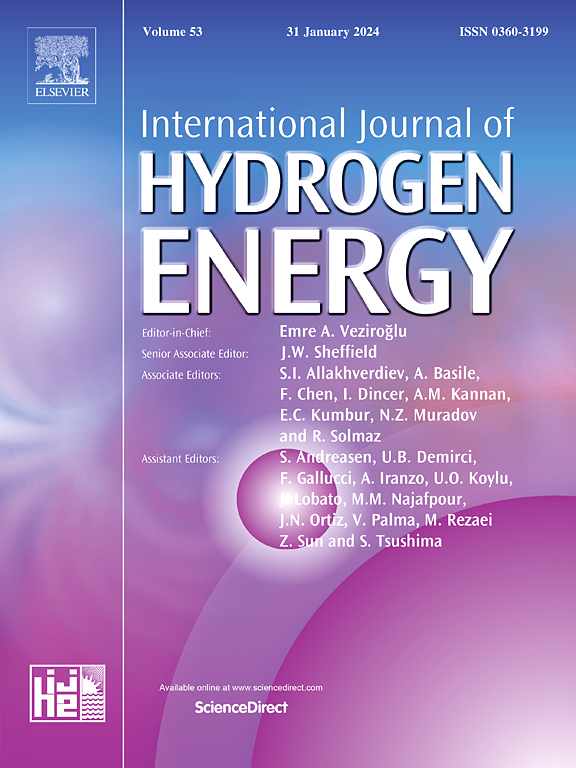炼油用低排放氢供应链:电解和气化大规模生产的评估
IF 8.1
2区 工程技术
Q1 CHEMISTRY, PHYSICAL
引用次数: 0
摘要
炼油工业是一个主要的氢消费国,主要依赖于化石燃料衍生的氢。虽然最近的文献关注的是水电解制氢,但(废弃)生物质气化是另一种低排放制氢的有效方法,炼油行业也很有可能迅速采用这种方法。本研究对炼油用氢的整个供应链进行了技术经济评估,并分析了剩余生物质气化和水电解途径的lca -气候变化。分析了两种生产方法相结合的潜在经济效益和环境效益。其中包括一个真实的案例研究,包括四种不同的场景,使用来自炼油厂的数据,加上当地数据和对潜在弃电和电价的未来预测。分析了炼油厂每小时制氢量和需求概况,以准确评估存储需求。结果表明,结合这两种技术不会产生明显的环境或成本效益,剩余生物质气化成为基本情况下最有利的配置。敏感性分析表明,如果剩余生物质价格足够高,电解制氢可能更具成本效益。地下储氢(盐洞)因其投资少而重要性突出,而其他储氢方式会显著提高氢的平准化成本(LCOH)。这项研究表明,与电解相比,气化制氢的碳密度更低,成本更具竞争力。实现低LCOH值和温室气体排放在所有情况下都是可行的,这表明水电解和剩余生物质气化在经济上都是促进低排放全球能源系统的可行选择。本文章由计算机程序翻译,如有差异,请以英文原文为准。
Low-emission hydrogen supply chain for oil refining: Assessment of large-scale production via electrolysis and gasification
The refining industry is a major hydrogen consumer, mainly relying on fossil fuel-derived hydrogen. While recent literature has focused on the production of hydrogen from water electrolysis, (waste) biomass gasification is another effective method for low-emission hydrogen production, and the refining industry is well positioned for its rapid adoption. This study conducts a techno-economic assessment of the whole supply chain of hydrogen for oil refining and analyses the LCA-climate change for residual biomass gasification and water electrolysis pathways. The potential economic and environmental benefits of combining both production methods are also analyzed. A real case study featuring four different scenarios, using data from a refinery, coupled with local data and future projections for potential curtailment and electricity prices, is included. The hourly hydrogen generation and demand profiles of the refinery were analyzed to accurately assess storage requirements. Results indicate that combining both technologies does not result in clear environmental or cost benefits, with residual biomass gasification emerging as the most advantageous configuration for the base case. Sensitivity analysis reveals that hydrogen produced via electrolysis may become more cost-effective if residual biomass prices are high enough. The importance of underground storage (salt cavern) is highlighted due to its low investment, while other storage methods can significantly increase the Levelized Cost of Hydrogen (LCOH). This study demonstrates that hydrogen production through gasification can be less carbon-intensive and more cost-competitive than electrolysis. Achieving low LCOH values and greenhouse gas emissions is feasible in all scenarios, indicating that both water electrolysis and residual biomass gasification are economically viable options for contributing to a low-emission global energy system.
求助全文
通过发布文献求助,成功后即可免费获取论文全文。
去求助
来源期刊

International Journal of Hydrogen Energy
工程技术-环境科学
CiteScore
13.50
自引率
25.00%
发文量
3502
审稿时长
60 days
期刊介绍:
The objective of the International Journal of Hydrogen Energy is to facilitate the exchange of new ideas, technological advancements, and research findings in the field of Hydrogen Energy among scientists and engineers worldwide. This journal showcases original research, both analytical and experimental, covering various aspects of Hydrogen Energy. These include production, storage, transmission, utilization, enabling technologies, environmental impact, economic considerations, and global perspectives on hydrogen and its carriers such as NH3, CH4, alcohols, etc.
The utilization aspect encompasses various methods such as thermochemical (combustion), photochemical, electrochemical (fuel cells), and nuclear conversion of hydrogen, hydrogen isotopes, and hydrogen carriers into thermal, mechanical, and electrical energies. The applications of these energies can be found in transportation (including aerospace), industrial, commercial, and residential sectors.
 求助内容:
求助内容: 应助结果提醒方式:
应助结果提醒方式:


